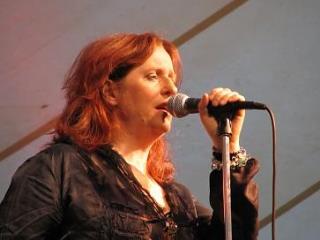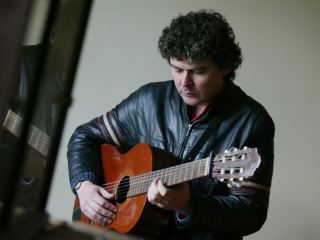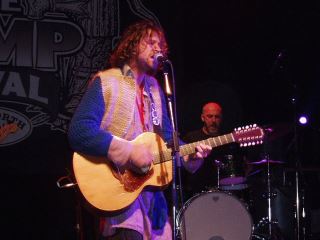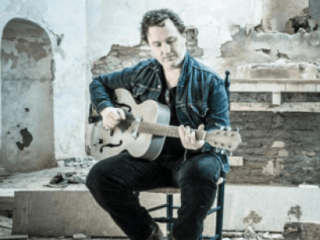FolkWorld #68 03/2019
Cúl an Tí: Songs and Cartoons
Folk on the Silver Screen: The Cúl an Tí series celebrates traditional Irish song with beautifully animated short films.
First seen on Irish TV and now available on DVD.

 "Cúl an Tí: Amhráin is Beochaintí (Songs and Cartoons)", Fócas Films / Cartoon Saloon / Kíla Records, 2018
"Cúl an Tí: Amhráin is Beochaintí (Songs and Cartoons)", Fócas Films / Cartoon Saloon / Kíla Records, 2018
Songs and Singers:
1. An tAmhrán Bréagach
(Pól Ó Ceannabháin)
2. Cill Aodáin
(Danny O’Reilly)
3. Dónal na Gréine
(Cathal Ó Curráin)
4. Laoi an Lagáin
(Mary Coughlan)
5. An Spailpín Fánach
(Mundy)
6. An Raibh tú ar an gCarraig?
(Liam Ó Maonlaí)
7. Cuirfimid Daeindí
(Bernie Pháid)
8. Aonach Bhearna na Gaoithe
(Irial Ó Ceallaigh)
9. An tEarrach Thiar
(Lisa Hannigan)
10. Cúl an Tí
(John Spillane)
11. Tá Mé Gonna Getcha
(Rónán Ó Snodaigh)
12. Fé Bhláth
(Imelda May)
Film producer Éamon Ó Cualáin feared that traditional Irish songs were being made redundant by the digital age and that Irish children were only learning songs they listened to online. So he came up with the idea to reinvigorate some Irish language songs by recording new versions and having animations made of them.
The Cúl an Tí series has been recently shown on TG4, the Irish public service broadcaster for Irish-language speakers, as a 6-episode series,
with a second series in pre-production.
Presenter Pól Ó Ceannabháin travelled to schools around the country introducing school children to well and lesser known Irish songs and poems.
Each song has been animated with the help of the award winning Cartoon Saloon studio of Secret of Kells and Song of the Sea fame.
Kíla provided the music. With its roots in traditional Irish music, the group has created its own distinctive world music style. Only recently
Kíla celebrated their 30th anniversary at Dublin's National Stadium.
To take it to the next level, Kíla published a DVD aimed at inspiring children to learn these songs through the combination of music and animation,
containing downloadable mp3s, lyrics and translations and the choice of karaoke-style subtitles.
Kíla's Rossa Ó Snodaigh said making the songs and animations available in a single package "as opposed to spread over six programmes" means they could be used in schools, singing clubs and at home to aid the teaching of the songs.
The selected songs have been reinterpreted by popular Irish singers such as Kíla's Rónán Ó Snodaigh,
Mary Coughlan, Mundy, Liam Ó Maonlaí, Bernie Pháid, Lisa Hannigan, John Spillane and Imelda May.
"It was actually wonderful to hear some of the more well known singers bring their style to bear on the traditional songs," said Rossa Ó Snodaigh.
"Most performers were very excited by the challenge and the opportunity to sing songs 'as Gaeilge', some were reticent because they felt their Gaeilge wasn’t up to scratch, but Colm [Ó Snodaigh] went over the lyrics, their sounds and meanings with them which gave them the confidence to perform them to their best."
There are popular songs such as Cill Aodáin written by Irish poet Antoine Ó Raifteirí (1779–1835),
who is often called the last of the wandering bards, about his hometown Cill Aodáin (Killedan) in County Mayo.
He wrote the poem to win back the favour of his landlord who had expulsed him for accidentally killing one of his horses.
It is one of Raifteirí's most enduring poems, still learned by Irish school children, and sung here by Danny O'Reilly of indie rock band The Coronas.
An Spailpín Fánach (The Wandering Labourer) is the haunting lament of a man who had to become a spailpín, an itinerant and seasonal farmworker,
because of his family's eviction. To avoid this harsh life, he joined the French army to fight overseas.
I have heard it sung by Sean Tyrrell,[23]
Cathy Jordan (Dervish)[3]
and Oisín Mac Diarmada (Téada).[53]
Here it is given by Irish singer-songwriter Mundy, who is best known for his 2002 summer hit, July. In 2003, he contributed to Afro Celt Sound System's album Seed.
In 2006, Mundy recorded an Irish language version of Steve Earle's Galway Girl (which Earle had recorded with accordionist Sharon Shannon), entitled Cailín na Gaillimhe.
An Raibh tú ar an gCarraig? is a popular slow air. I know instrumental versions from
Junior Crehan,[42]
Breanndán Ó Beaglaoich,[48]
Ronan Browne,[21]
Niamh Ni Charra,[33]
Patrick D'Arcy[50]
and Kevin Rowsome.[21]
Its various English titles – Have You Been at Carrick? or Were You at the Rock? – are translations of the song's first line.
It is sometimes said to have been used in Ireland to signify the illegal holding of the Catholic Mass in the 17th century.
In this interpretation, believed by piper Séamus Ennis or singer Seosamh Ó hÉanaí (Joe Heaney), it refers to a mass rock rather than a placename.
Nevertheless, the original version was probably conceived as a love song rather than an allegory.
It is sung by Liam Ó Maonlaí, best known as the frontman of the Hothouse Flowers, who combine traditional Irish music with influences from soul, gospel and rock.
You can watch a beautiful version of An Raibh tú ar an gCarraig? on YouTube featuring Glen Hansard and Marketa Irglova (The Swell Season).
In 2005, Maonlaí had released a solo album entitled Rian (trace, mark) which is a collection of traditional songs in Irish.
Laoi an Lagáin (My Lagan Love) is based on an old traditional Irish air collected in the early 1900s in County Donegal.
Joseph Campbell (Seosamh Mac Cathmhaoil, 1879–1944), who collaborated with composer Herbert Hughes, put some words to it.
This here is a translation into Irish by poet and playwright Gabriel Rosenstock (whose son Tristan plays the bodhrán with traditional Irish quintet Téada).
It is sung here by jazz and folk vocalist Mary Coughlan, known for songs such as Magdalen Laundry and My Land Is Too Green.
In the mid 1990s, she had joined A Woman's Heart Volume 2, in the 2000s Coughlan celebrated Billie Holiday whose alcohol-affected life had a great many parallels to her own.
Dónal na Gréine (Daniel of the Sun) is a lesser known track;
Belfast singer Gráinne Holland has laid it down.[46]
I think Lasairfhíona Ní Chonaola from the Aran Islands Gaeltacht did An tAmhrán Bréagach (Song of Lies) before.
Her fellow Aran islander Máirtín Ó Direáin (1910–1988) wrote the poem An tEarrach Thiar (The Western Spring). His poetic work is held in high regard,
broaching the issues of past and present, city and country, the English and Irish speaking domain.
It was voted inside Ireland's Favourite 100 Poems by readers of the Irish Times in 1999. So was the title track, Cúl an Tí (The Back of the House),
written by Seán Pádraig Ó Ríordáin (1916-1977), one of the foremost Irish language poets of the 20th century whose work has been included in the standard Irish curriculum.
It is a rather dark poem which describes having been diagnosed with tuberculosis and living in isolation in an annexe of the house.
I know a version sung by Tony Reidy,[23]
here it is given by Cork singer-songwriter John Spillane.
He has released two albums in Irish. First of all, a collaboration with Irish poet Louis de Paor under the moniker "The Gaelic Hit Factory".
Secondly, a best-selling collection of traditional Irish Songs We Learned at School.
Photo Credits:
(1) 'Cúl an Tí: Songs and Cartoons ',
(2) TG4,
(3) Cartoon Saloon,
(4) Kíla (ft. Rónán Ó Snodaigh,
(5) Bernie Pháid,
(7) John Spillane,
(9) Mundy
(unknown/website);
(6) Mary Coughlan
(by MaxPride/Wikipedia);
(8) Liam Ó Maonlaí
(by Biguana/Wikipedia).
FolkWorld - Home of European Music
 Layout & Idea of FolkWorld © The Mollis - Editors of FolkWorld
Layout & Idea of FolkWorld © The Mollis - Editors of FolkWorld






